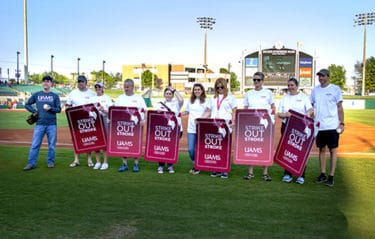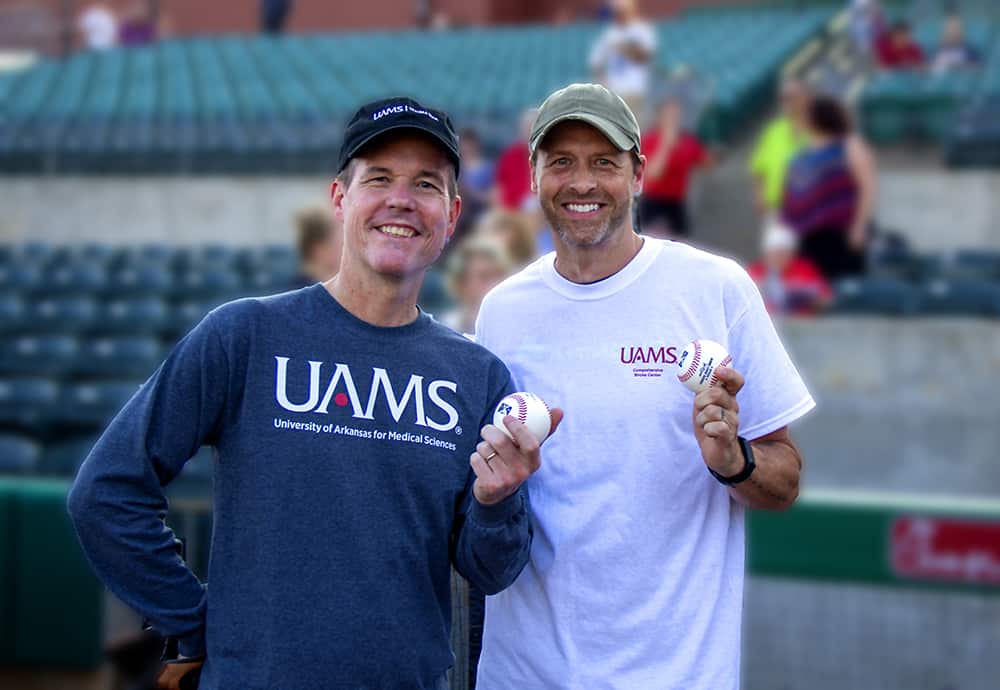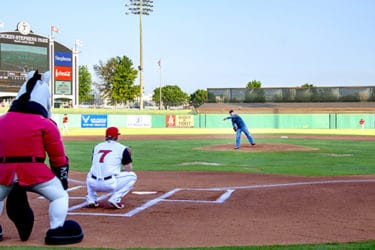Survivor Throws Strike Against Stroke after ‘Amazing’ Recovery at UAMS
| Even before he threw a ceremonial strike-out pitch at UAMS Strike Out Stroke Night at Dickey-Stephens Park in North Little Rock on May 23, Timothy Raines already felt like a winner.
With help from the UAMS Stroke Program, Raines survived a stroke in November and was ready to throw a baseball 60 feet from the pitcher’s mound to an Arkansas Travelers catcher.
It was the ninth year UAMS organized Strike Out Stroke game nights at the park to raise awareness of stroke and educate the public about stroke symptoms and risk.
UAMS Chancellor Cam Patterson, M.D., MBA, took to the mound before Raines, throwing the first ceremonial pitch.
“Timothy’s recovery has been a great testament to the importance of UAMS’ Comprehensive Stroke Center designation,” Patterson said. “It places UAMS among the top stroke centers in the country that have the resources and highly skilled health care teams with advanced training to handle the most complex stroke cases.”
UAMS Medical Center in July became the first and only health care provider in Arkansas to be certified as a Comprehensive Stroke Center by The Joint Commission.
The Joint Commission is an independent, not-for-profit organization that evaluates and accredits more than 20,000 health care organizations and programs in the United States.
To help Arkansans learn how to survive stroke, the UAMS Arkansas Stroke Assistance through Virtual Emergency Support (AR SAVES) leadership, staff, volunteers and community partners organize and are a part of dozens of events throughout the year, including “Strike Out Stroke” nights.
They were at Dickey-Stephens again this year to provide stroke education and toss brain-shaped stress toys into the stands. A volunteer selected from the stands participated in a card game about stroke symptoms and win prizes.
“Strike Out Stroke Night is one of the many types of events we continue to use to appeal to different audiences with the goal of educating the public about how to recognize stroke symptoms and get timely treatment,” said Renee Joiner, director of AR SAVES.
Arkansas ranks seventh in the nation in stroke death rates after many years in first place. Surviving a stroke is becoming more likely as more community hospitals join the AR SAVES network.

Volunteers display cards to be used for a game for educating people as to stroke symptoms. Patterson, far left, and Raines, far right, stand with them.
The program uses a high-speed video communications system to help provide immediate, life-saving treatments to stroke patients 24 hours a day. The real-time video communication enables a stroke neurologist to evaluate whether emergency room physicians should use a clot-busting blood thinner within the critical three-hour period following the first signs of stroke.
Raines was one of those patients. He was treated first at an AR SAVES hospital near his home, Baptist Health Medical Center-Arkadelphia, before being transferred to UAMS Medical Center for the removal of a clot from Raines’ right middle cerebral artery.
After experiencing paralysis, loss of speech and facial drooping during his stroke, his only lasting issue is some difficulty from time to time in finding a word he wants to say, yet the ending to Timothy’s story has been a happy one
“It’s totally amazing,” Raines said about his recovery. “When I was in the hospital, being left handed, one of my thoughts was, ‘If I get out of here and my hand works again, I want to do great things with it. This is fantastic, something I don’t get to do every day.”
Minutes later, he threw his pitch from the mound right to the catcher and over home plate as thousands cheered and applauded.

